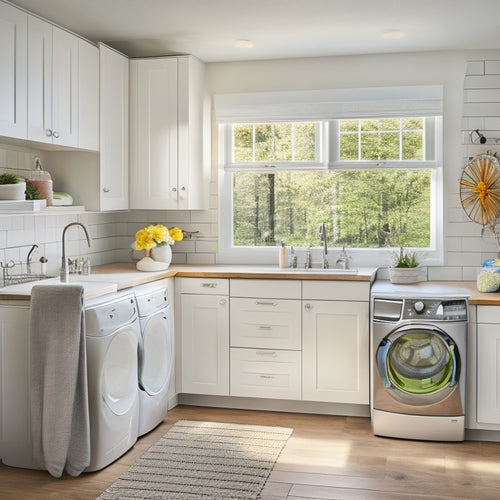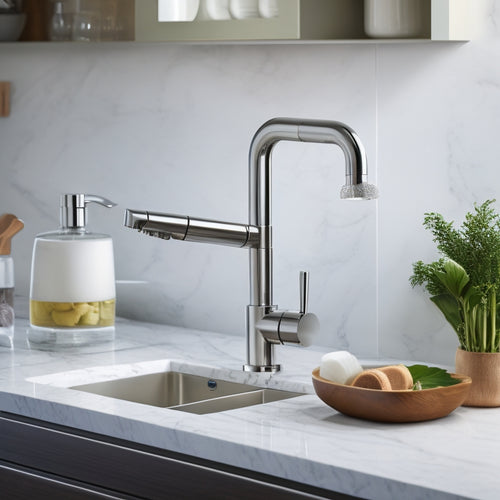
Clearing Clutter From Kitchen Counters and Islands
Share
You're tired of cluttered kitchen counters and islands holding you back from cooking efficiently. Start by identifying clutter hotspots, like sink areas and meal prep zones, and take note of the types of items that accumulate there. Purge unnecessary items by categorizing them into keep, donate/sell, and discard piles, and apply the 80/20 rule to prioritize essential kitchen items. Organize essentials into task-specific zones, and use creative storage solutions to maximize counter space. By implementing these strategies, you'll be well on your way to a clutter-free kitchen. Now, discover how to maintain your newfound space and transform your kitchen into a haven that sparks joy.
Key Takeaways
• Identify clutter hotspots like sink areas and meal prep zones to tackle clutter buildup in kitchens.
• Purge unnecessary items by categorizing them into keep, donate/sell, and discard piles, applying the 80/20 rule.
• Organize essentials into task-specific zones for efficient cooking, including food prep, cooking, and clean-up areas.
• Utilize creative storage solutions like spice carousels, drawer dividers, and repurposed items to maximize storage potential.
• Adopt a clean-as-you-go habit and set aside daily time for tidying up to maintain a clutter-free kitchen.
Assessing Clutter Hotspots in Kitchens
Take a step back and scan your kitchen counters to identify the clutter hotspots that drive you crazy, such as the area around the sink, the countertops near appliances, or the zones where you prep meals. These areas tend to accumulate clutter due to kitchen traffic and the way you move around the space.
Understanding your workspace psychology is key to tackling clutter. Notice how you instinctively place items in these areas, making them prone to clutter buildup.
Once you've identified these hotspots, take note of the types of items that tend to accumulate in each zone. Are there piles of dirty dishes near the sink? Do kitchen gadgets and utensils clutter the countertops around your appliances? Are there crumbs and spills near your meal prep areas?
Purging Unnecessary Kitchen Items
You regularly come across kitchen items that haven't been used in ages, and it's time to acknowledge that they're simply taking up valuable space and contributing to clutter.
It's hard to let go, but holding onto items out of emotional attachment or guilt trips only keeps you stuck in a cluttered kitchen. Be honest with yourself: when was the last time you used that slow cooker or bread maker? If it's been over a year, it's probably safe to let it go.
Start by categorizing items into three piles: keep, donate/sell, and discard. Be ruthless – if you haven't used it in the past year, it's likely you won't miss it.
Consider the 80/20 rule: 80% of the time, you likely use 20% of your kitchen items. Identify the items that fall into that 20% and prioritize keeping those. Let go of the rest, and watch your kitchen transform into a clutter-free haven that sparks joy and belonging.
Organizing Kitchen Essentials by Zone
Now that you've purged your kitchen of unnecessary items, it's time to organize the remaining essentials into zones that make sense for your cooking style and workflow. This process, known as zone mapping, helps you create task stations that streamline your cooking process.
By grouping similar tasks together, you'll reduce clutter and increase efficiency.
To start, identify the main zones in your kitchen, such as:
-
Food Prep Zone: where you'll store utensils, cutting boards, and countertops for food preparation
-
Cooking Zone: where you'll place your stove, oven, and cooking utensils
-
Clean-up Zone: where you'll store your sink, dishwasher, and cleaning supplies
Once you've designated your zones, assign specific tasks to each station. For example, your food prep zone might include a knife block, spice rack, and can opener.
Creative Storage for Small Items
Utilizing every available inch, maximize your kitchen's storage potential by incorporating clever containers and cleverly repurposed items to keep small essentials at your fingertips. This is especially true for frequently used items like spices, oils, and condiments. Consider investing in a Spice Carousel, which can be mounted on a wall or placed on a countertop, providing easy access to your favorite seasonings.
For smaller items like utensils, drawer dividers can be a game-changer. Divide your kitchen drawers into sections, assigning a specific space for each type of utensil. This will prevent clutter from building up and make it easier to find what you need when you need it.
You can also repurpose items like mason jars or tin cans to store small items like buttons, safety pins, or beads. By implementing these creative storage solutions, you'll be able to free up valuable counter space and create a more organized, functional kitchen that makes you feel in control and at peace.
Maintaining a Clutter-Free Kitchen
One key habit to adopt for maintaining a clutter-free kitchen is to clean as you go, wiping down countertops and putting away ingredients and utensils immediately after use. This daily habit prevents clutter from building up and makes cooking more efficient.
By incorporating mindful cooking practices, you'll find yourself more present and focused in the kitchen.
Here are some additional tips to help you maintain a clutter-free kitchen:
Set aside 10-15 minutes each day to tidy up your kitchen, putting away dishes and wiping down surfaces.
Implement a 'one in, one out' policy for new kitchen gadgets and tools to prevent clutter from accumulating.
Designate a specific spot for frequently used items, such as a utensil holder or spice rack, to keep them organized and within reach.
Frequently Asked Questions
How Do I Handle Clutter From Family Members Who Resist Change?
"When faced with family members' resistance, you'll find flexibility is key. Firmly set boundaries, acknowledging emotional triggers, and gently guide them toward gradual change, fostering a sense of belonging and shared responsibility."
What Are Some Eco-Friendly Ways to Dispose of Old Kitchen Items?
You're taking a huge step towards a more sustainable lifestyle! Consider sustainable donation options like local charities or online platforms, and aim for zero waste by repurposing or recycling items that can't be donated.
Can a Cluttered Kitchen Affect My Mental and Physical Health?
"Don't you feel overwhelmed when surrounded by chaos? Cluttered kitchens can indeed affect your mental and physical health, adding to your mental load and triggering stress. By clearing out the clutter, you'll reduce stress triggers and create a more peaceful space."
How Often Should I Clean and Declutter My Kitchen Counters?
You should establish daily habits, like wiping down counters after meals, and create a cleaning schedule to maintain a clutter-free kitchen, aiming to declutter and deep clean at least once a week to promote a healthier you.
Are There Any Specific Decluttering Strategies for Small Kitchens?
You'll maximize space in your small kitchen by embracing Space Savers and Compact Design principles. Opt for multi-functional appliances, wall-mounted shelves, and collapsible storage to create a clutter-free haven that feels spacious and welcoming.
Related Posts
-

Revamp Your Laundry Room With Smart Space-Saving
You're tired of feeling cramped and disorganized in your laundry room, and it's time to revamp the space to make the ...
-

Revolutionize Your Kitchen Sink With Must-Haves
Elevate your kitchen sink experience with must-have essentials that prioritize organization, efficiency, and style. S...

